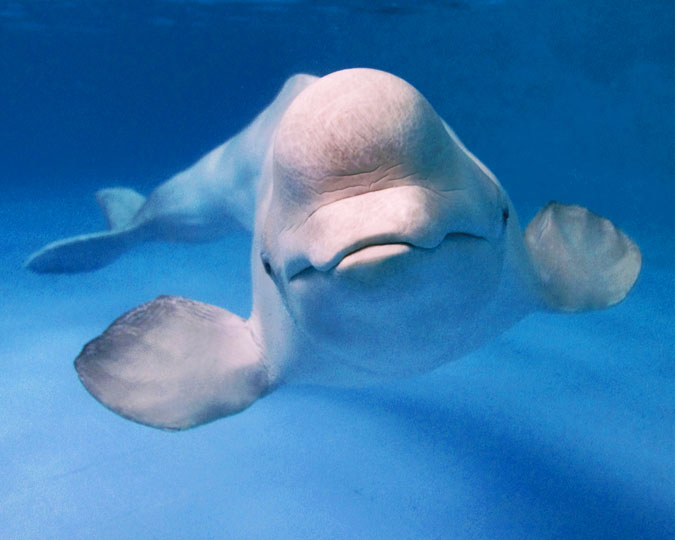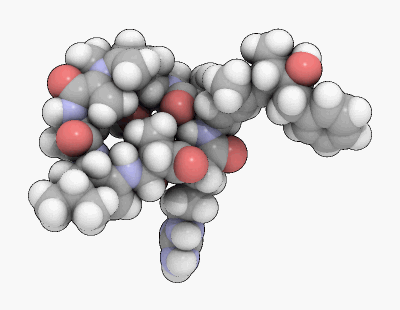 |
| Beluga photo via premier.gov.ru |
A while back I found out the whole story about why Beluga whales were washing up on the shores of the St. Lawrence around Montreal--whales whose carcases were so contaminated with toxins that they had to be handled as toxic waste. Turns out it had to do with farmers in the American Midwest applying fertilizer to their fields. Excess nitrogen and phosphorus was washing into the rivers in the (rather immense) Mississippi catchment basin, concentrating in the waterways, spilling out into the Gulf where it was creating a dead zone. Algae from the dead zone found their way up the Atlantic coast in blooms, generating the neurotoxin found in red tide. Various predators concentrated the toxin up the food chain as the bloom moved north, finally resulting in dead whales in the St. Lawrence. Everything is connected.
 |
| Lake Erie photo via National Oceanic Service |
 |
| microcystin-LR molecule via Toxmais, mostly because it's so frickin' cool! |
Cyanobacteria require a lot of phosphorus and other nutrients to go from the normal, background levels to toxic bloom status, and they get these nutrients from septic systems, lawn fertilizer (particularly from heavy users like golf courses), everyday additions to the sewage stream like shampoo and toothpaste, and, of course, from industrial farming.
At least one Toledo-area golf course has acknowledged that they do use a lot of fertilizers to keep the course green, and also have a tough time irrigating the course because of the cyanobacteria clogging up their intake pipes. Pretty much instant karma, really.
The problem is that we don't account for our waste. If we can offload our waste on the natural world, that is seen as a win. We don't have to deal with it, clean it up, or pay any attention to it. And, of course, this eventually bites us in the ass. "When you're up to your ass in alligators, it's hard to remember that your intention was to drain the swamp" as the old poster used to put it.
This offloading is strangely codified in modern economic theory; natural systems are completely left out of the equation. But rather than assign a price to natural systems, shouldn't we perhaps toss the the current theory? There's a lot of serious concerns with attaching a price to nature--mostly that nature is not a commodity. Here on Vancouver Island we use the natural climax ecosystem to help clean our water. But forestry companies don't see that as value (nor does current economic theory). If the forest aren't cut down, their value isn't realized. That they have value without being cut down and processed is beyond the thinking of the exploitation class. In fact, cutting down the forest is seen as a good, because then you have to build something to process the water, and that adds to the country's economic output. Plus, you can put condos on the site of the former forest.
It's insane, but that's the reality of neo-conservative (or neo-liberal) economics. (Funnily enough, they're the same thing). Destruction is a positive and conservation is a negative. Hurricane Katrina was a positive (massive amounts of reconstruction money was spent, school systems were taken out of public hands and turned over to the private sector, all that makes profits), but creating a park is a negative, because it prevents profit from being made.
Farmer's don't intend to destroy the Toledo municipal water supply, but there's no incentive to stop over-fertilizing, and a lot of incentive to continue.
We all do it. The biggest ecological nightmare is fossil fuel, but we aren't in any hurry to stop using it. There's to many incentives to keep using it, and thinking about alternatives has almost been completely shut down. Everything is built around fossil fuel use, and the thought of changing, well, the difficulties seem overwhelming. But they are only overwhelming because we want to have the same life we have now, just without the global warming.
Of course, that's not possible. Period, full stop. We can either have a consumer culture that is going to kill us sooner rather than later, or we can have an inhabitable planet, but almost none of the stuff we think is essential. Personally, I think sewage systems, the germ theory of disease, and soap would make for a liveable world. But the world doesn't seen to see it that way. Consume and die is the path we're on.
I know, pretty upbeat, eh? I'd love to be proven wrong, but I don't see that happening. Everything is connected, from the purchase of a plastic sippy cup for your child, to the toxic load s/he will carry in his/her body, to the Pacific Trash Vortex, to residents of Toledo not being able to drink the water in their taps. We don't really get that, but we should.
No comments:
Post a Comment